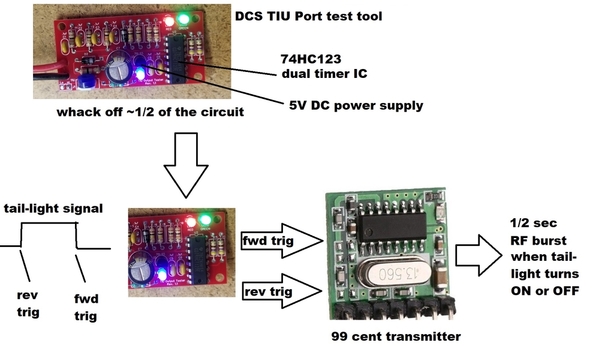gunrunnerjohn posted:...Obviously, if we can come up with something with sufficient flexibility that doesn't require the uP, that would likely be a better plan, easier for anyone to build and use.…
Stan, a one-function device would work for many applications, I tend to look to see how broad a spectrum I can cover if the costs don't get out of hand. The other plus is that the uP can be reprogrammed if a new requirement comes along. However, there is merit to placing some sort of limit on the functionality to keep the cost and complexity within reason.
If this ends up being something the user builds, he could also leave off parts for extra channels if he doesn't need them in his application.
Interesting discussion, how about this "what."
Using engine movement as the trigger, the reaction is flipping the Polar Express hobo to the top of the car. When the engine stops, the hobo goes back into hiding.
I realize this is far more involved (and expensive) than the original premise, but would be fun to watch the faces of the "kids" when the hobo appears/disappears.
I suspect something like a model airplane servo would work for the hobo job, that's how I automated my Tie-Jector car before Lionel decided to release the TMCC version.
gunrunnerjohn posted:I think we have a bit more than "hello world", at least what I'm considering. I'm still a little fuzzy on the ESP8266 in a stand-alone environment and programming it from the Arduino IDE, that doesn't sound quite right, but maybe I just don't get it yet.
I looked around and I find a ton of slightly different ESP8266 products, hard to know which one to pick.
What I mean by a 'hello world' in this case is having one module set up to send data, and the other to receive said data. the bulk of the code is in the getting each module to talk to each other. This is usually done by setting up one module as a wifi access point and hosting an html page on it to store the data states, and having other modules read the page to look for new data.
There are a lot of options out there for the esp8266, but the two main versions of use today are the esp-01 and esp-12. The 01 is the type that is usually found on a board with 8 pins in a 4x2 pattern. These have 2 GPIO's, and cost about $1.85 from the usual suppliers out of China. The ESP-12 uses the same 8266 chipset, but it has more of the pins connected for you to use. the -12 has 11 GPIOs, and one 10 bit ADC. These usually come in a metal can package similar to other ble and wifi chips. the esp-12 usually cost around $2.25 each. While more powerful, they are harder to use for hobby level work because of the package type.
In the more general of the what and how, it's my understanding that the what is to have a wireless device that takes an on/off from some source, such as an unused feature in an engine or perhaps a head light or back-up light and transmits that information to another device that can turn on/off a relay or similar device to match the state. ex: when the back-up light in a main engine turns on, so will the one in a dummy unit. The hows, as I understand it so far need to do this in a way that allows for many of these devices to work along side each other without causing each other to malfunction, or interfering with any other devices.
Is that about right?
Sounds about right. I guess the only real way to find out more about the ESP8266 is to tinker with it, but with everything going on here, I'm not sure I have the time to actually do it justice.







